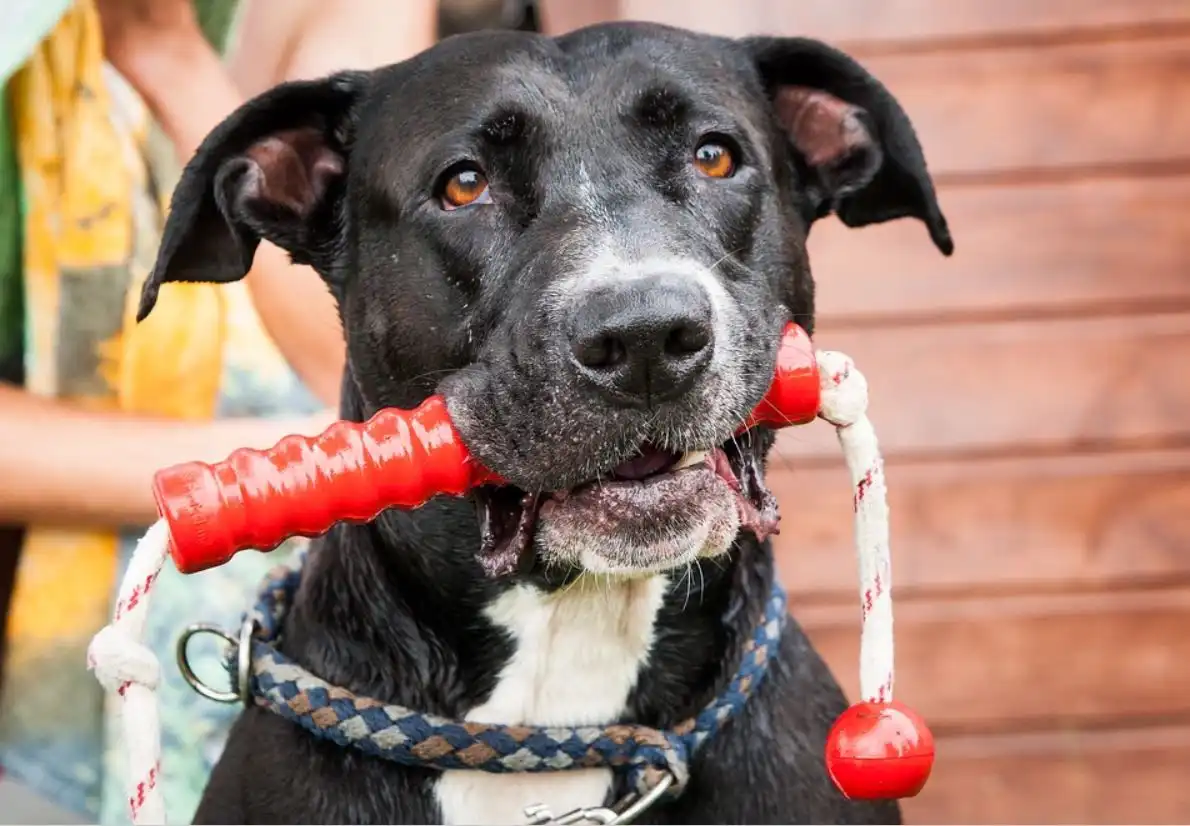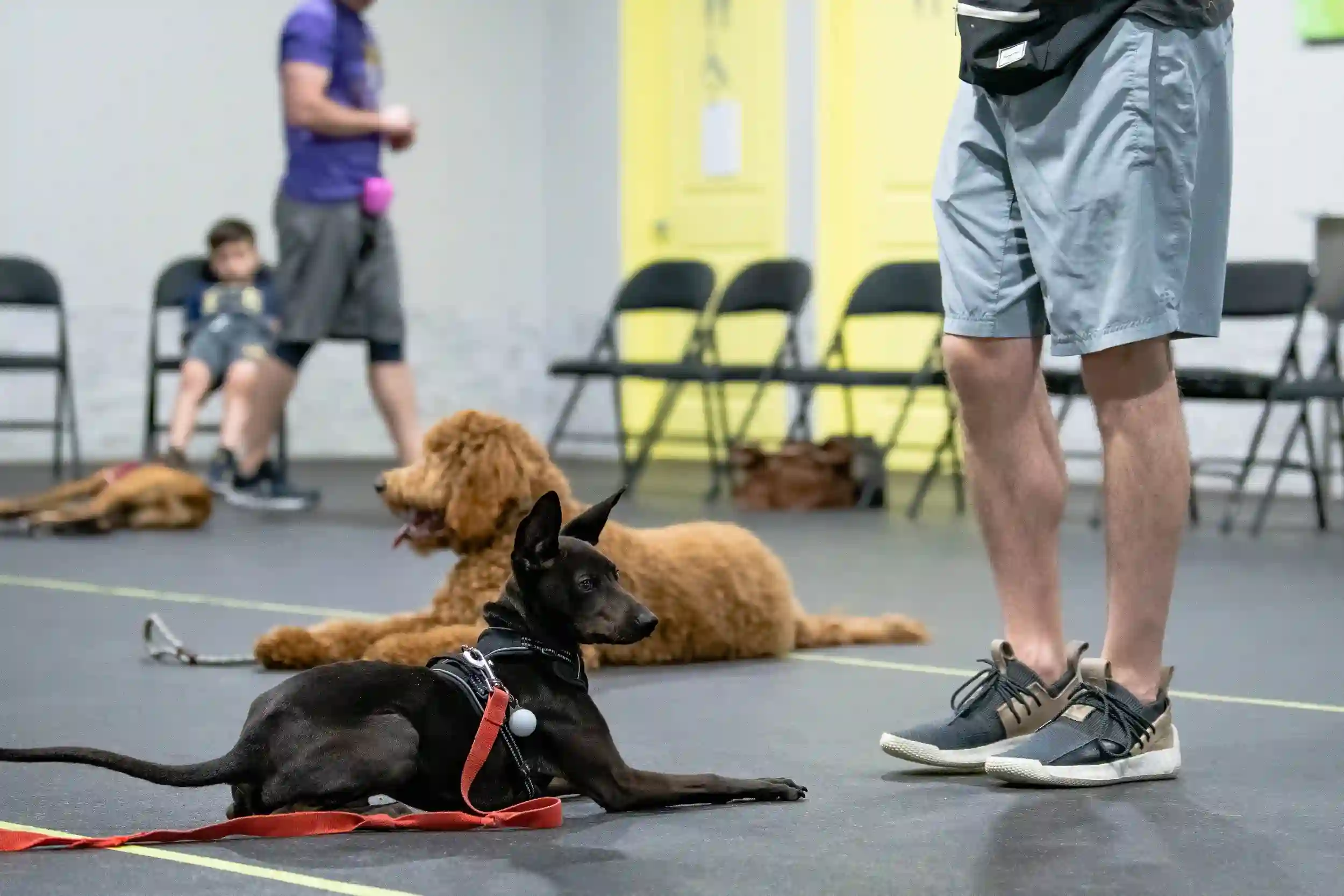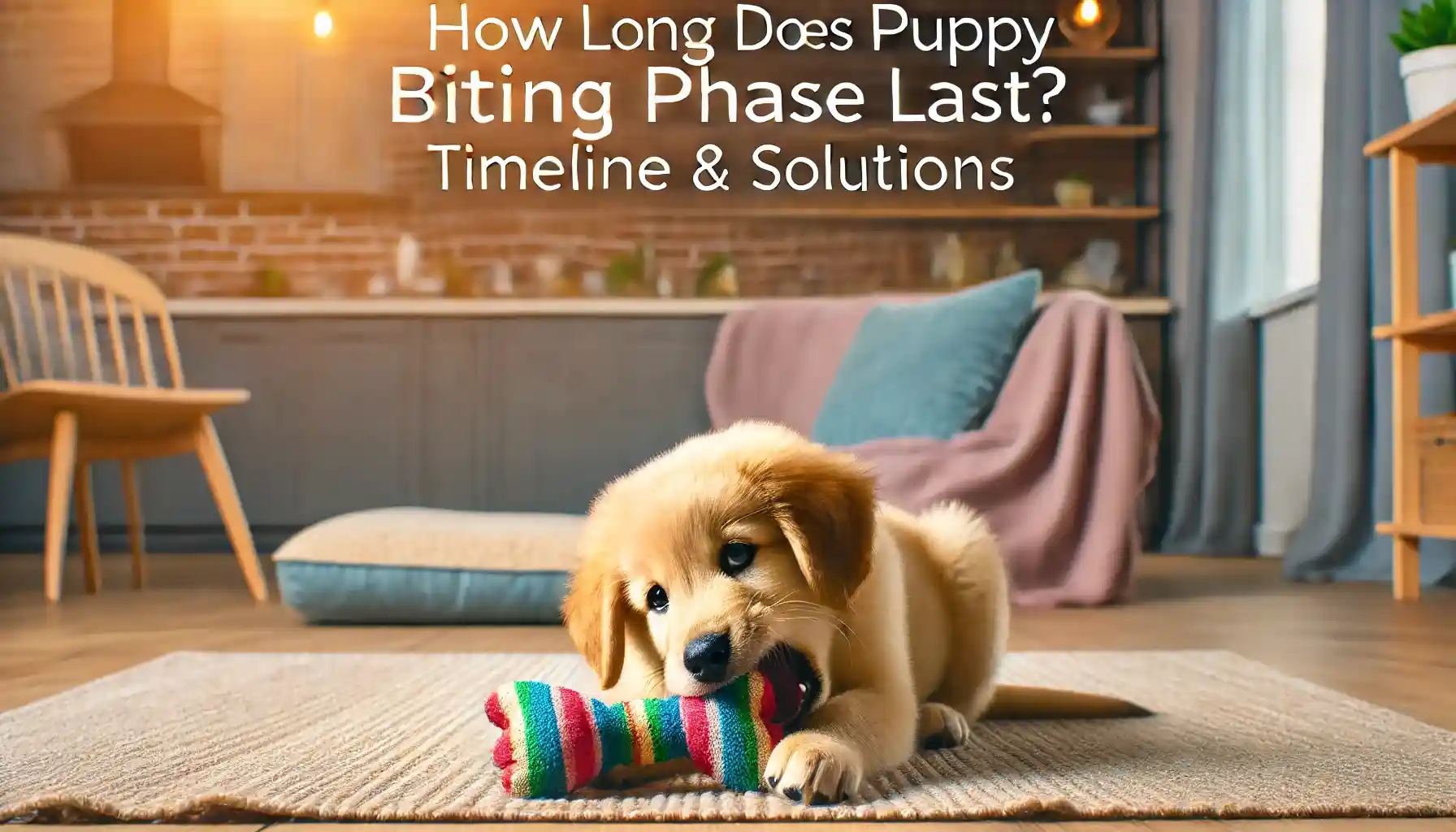Those razor-sharp puppy teeth can leave quite an impression—both literally and figuratively. If you’re wondering how long does puppy biting phase last, this comprehensive guide explains the typical timeline, influencing factors, and proven techniques to help your puppy develop proper bite inhibition.
As a certified dog trainer with over 12 years of experience working with puppies of all breeds, I’ve helped countless pet parents navigate the challenging puppy biting phase. While those needle-sharp teeth might have you questioning your decision to bring home a puppy, I can assure you that this behavior is both normal and temporary. The question of how long does puppy biting phase last is one of the most common concerns I hear from new puppy owners—and for good reason.
This comprehensive guide draws on both scientific research and practical experience to help you understand the puppy biting timeline, recognize breed-specific variations, and implement effective techniques to shorten the duration of excessive mouthing. Whether you’re currently sporting band-aids on your hands or preparing for a new puppy’s arrival, you’ll find actionable advice to help your furry family member develop appropriate bite inhibition.
Understanding the Puppy Biting Phase Duration
The puppy biting phase typically lasts from the time puppies get their baby teeth (around 2-3 weeks of age) until they complete their adult teething process, generally around 6-8 months of age. However, the most intense biting behavior usually peaks between 8-20 weeks (2-5 months) old.
So how long does puppy biting phase last exactly? Let’s break down the typical timeline:
| Age | Biting Behavior | What’s Happening |
|---|---|---|
| 2-3 weeks | Begins exploring with mouth | Baby teeth start erupting |
| 3-8 weeks | Play-biting littermates | Learning bite inhibition from mother and siblings |
| 8-12 weeks | Intense mouthing of people and objects | Teething discomfort + natural exploration |
| 3-5 months | Gradual decrease in frequency and pressure | Baby teeth falling out, adult teeth coming in |
| 6-8 months | Occasional mouthing during play | Completing adult teeth development |
| 8+ months | Minimal mouthing with good training | Mature bite inhibition established |
As you can see, while the question “how long does puppy biting phase last” doesn’t have a simple answer, most puppies show significant improvement by 6 months of age. In my professional experience, the most challenging period typically falls between 8-16 weeks, when puppies are experiencing both the discomfort of teething and the natural desire to explore their world through their mouths.
I worked with a Golden Retriever puppy named Cooper whose biting was particularly intense at 12 weeks. His owners were concerned that his behavior was abnormal. We implemented a consistent training plan, and by 20 weeks, his biting had decreased dramatically. By 7 months, he had developed excellent bite inhibition. This timeline is fairly typical for the breed, demonstrating that even when the biting seems severe, with proper guidance, puppies outgrow this phase on schedule.

Factors Influencing the Length of the Biting Phase
While understanding how long does puppy biting phase last in general terms is helpful, several factors can significantly influence the duration and intensity of this developmental stage for individual puppies:
Breed Characteristics
Some breeds are predisposed to more persistent mouthing behaviors:
- Retrievers (Labrador, Golden): Bred to carry items in their mouths, these breeds often have a longer and more intense biting phase, sometimes lasting until 8-9 months.
- Herding breeds (Border Collies, Australian Shepherds): May nip more due to inherited herding instincts, with focused training needed until 7-8 months.
- Terriers: Often exhibit more determined biting due to their prey drive, requiring consistent training through 6-7 months.
- Toy breeds (Chihuahuas, Yorkies): May show less intense biting but can take longer to develop bite inhibition due to owners often tolerating the behavior because of their small size.
Early Learning Experiences
Puppies that stay with their mother and littermates until at least 8 weeks of age typically learn better bite inhibition:
- Early Separation: Puppies removed from littermates before 8 weeks may miss crucial bite-feedback learning, potentially extending the biting phase by 1-2 months.
- Litter Size: Puppies from smaller litters may have fewer opportunities to learn appropriate play-biting boundaries.
Training Consistency
The single most influential factor in determining how long does puppy biting phase last is the consistency of your training response:
- Inconsistent Responses: When family members react differently to biting (some allow it, others scold), puppies receive mixed messages, potentially extending the phase by several months.
- Clear Boundaries: Households with clear, consistent training typically see the biting phase shortened by 1-2 months compared to the average.
I worked with a family with two children who had different reactions to their Beagle puppy’s biting—the younger child would squeal and push the puppy (inadvertently reinforcing the behavior), while the parents were implementing proper redirection techniques. Once we unified their approach, the puppy’s biting decreased significantly within just two weeks.
Physical Factors
Physical development and discomfort play significant roles:
- Teething Pain: Puppies experiencing more teething discomfort may bite more intensely until all adult teeth are in (around 6-7 months).
- Bite Structure: Breeds with different jaw structures and dental development may have varying timelines for the completion of the teething process.
A Border Collie puppy I worked with had particularly difficult teething with two retained baby teeth. His biting behavior persisted more intensely until the veterinarian removed the retained teeth at 7 months, after which the behavior improved rapidly.

Comparison of Biting Phases in Different Breeds
How long does puppy biting phase last can vary significantly between breeds due to genetics, physical development, and breed purpose. Understanding these differences can help set realistic expectations:
Sporting and Retriever Breeds
Labs, Goldens, Spaniels
- Duration: Typically 3-8 months, with more persistent mouthing
- Intensity: Moderate to high
- Key Characteristic: Strong retrieval instinct means more oral fixation
- Training Focus: Providing appropriate retrieval outlets and teaching “gentle” commands
I worked with a Labrador Retriever named Bailey whose biting phase was particularly persistent. Even at 6 months, she was still mouthing hands regularly during play. By focusing on retrieval games with appropriate toys and consistently redirecting her mouthing to these items, we saw significant improvement by 7.5 months. By 9 months, her mouthing was minimal and gentle.
Herding Breeds
Border Collies, Australian Shepherds, Cattle Dogs
- Duration: 3-7 months for general biting, but herding nipping instincts can persist longer
- Intensity: Often sharp, quick nips (mimicking herding behavior)
- Key Characteristic: May target moving objects, ankles, and heels
- Training Focus: Movement control exercises and providing mental stimulation
Terriers
Jack Russells, Fox Terriers, Bull Terriers
- Duration: 3-6 months
- Intensity: Often forceful and determined
- Key Characteristic: May combine biting with shaking (prey drive)
- Training Focus: Appropriate outlets for natural digging and tugging instincts
Guardian Breeds
German Shepherds, Rottweilers, Dobermans
- Duration: 3-7 months
- Intensity: Can be quite powerful even in young puppies
- Key Characteristic: May become more protective/territorial as they mature
- Training Focus: Early socialization and clear bite inhibition training
Brachycephalic (Flat-Faced) Breeds
Bulldogs, Pugs, Boston Terriers
- Duration: 3-6 months
- Intensity: Generally less intense due to jaw structure
- Key Characteristic: May have dental issues that affect biting behavior
- Training Focus: Regular dental checks and appropriate chew toys for their unique jaw structure
Toy Breeds
Chihuahuas, Yorkies, Maltese
- Duration: 3-7 months, sometimes longer due to owner permissiveness
- Intensity: Less damaging but often persistent
- Key Characteristic: Biting often tolerated due to small size, leading to prolonged behavior
- Training Focus: Treating biting seriously despite small size
When considering how long does puppy biting phase last for your specific puppy, breed tendencies provide a general guideline, but individual temperament still plays a significant role. I’ve seen German Shepherds with very soft mouths and Chihuahuas with surprisingly persistent biting behaviors.

Signs That the Biting Phase is Coming to an End
As pet parents eagerly await the answer to “how long does puppy biting phase last” for their individual puppy, looking for these progressive signs can provide encouragement that the end is in sight:
Physical Indicators
- Complete adult dentition: By 6-7 months, your puppy should have all 42 adult teeth, which generally coincides with reduced biting urges.
- Decreased chewing on inappropriate items: Less destruction of household items indicates both teething discomfort and oral exploration are diminishing.
- Reduced mouthing during handling: Being able to touch your puppy’s face, paws, and body without triggering biting responses.
Behavioral Changes
- Softer mouth pressure: When play-biting does occur, the pressure is significantly gentler than earlier months.
- Self-interruption: Puppy starts to catch and stop himself when beginning to mouth inappropriately.
- Increased impulse control: Better response to commands like “leave it” and “drop it” during play.
- Appropriate toy selection: Puppy independently chooses toys rather than hands/clothing for chewing needs.
- Calm greeting behaviors: Less excited jumping and mouthing when greeting family members.
I worked with a German Shepherd puppy named Max who had been a particularly enthusiastic biter. The first clear sign his biting phase was ending came when he began to “catch himself”—he would start to mouth a hand during play, then visibly pause and redirect himself to a nearby toy. This self-control began emerging around 5.5 months and was well-established by 7 months.
Many owners report that one week, they suddenly realize they haven’t been “shark attacked” in days—this moment often comes between 5-8 months of age, though as we’ve discussed, the timeline for how long does puppy biting phase last varies by individual and breed.
Effective Techniques to Manage the Biting Phase
While understanding how long does puppy biting phase last helps set realistic expectations, implementing effective training techniques can significantly reduce the intensity and potentially shorten the duration of problematic biting. Here are the most effective approaches based on both scientific research and my professional experience:
Redirection Strategy
Effectiveness rating: ★★★★★
This technique teaches puppies appropriate items to chew through consistent redirection:
- Keep appropriate chew toys within reach at all times
- The moment teeth touch skin, immediately substitute a toy
- Praise enthusiastically when puppy chews the appropriate item
- Be consistent—every family member must follow the same protocol
I worked with a family whose Lab puppy was a particularly enthusiastic biter. We implemented a “toy stations” approach, placing appropriate chew toys in every room of the house to ensure redirection was always possible. Within three weeks, the puppy began seeking out toys instead of hands, significantly reducing biting incidents.
Proper Teething Relief
Effectiveness rating: ★★★★☆
Since teething discomfort drives much of the biting behavior, providing appropriate relief can reduce the urge to bite:
- Freeze damp washcloths for puppies to chew
- Use specially designed cooling teething toys
- Provide appropriate dental chews (vet-approved for puppies)
- Consider frozen carrots as natural, edible chew options
Disengagement Technique
Effectiveness rating: ★★★★☆
This technique teaches puppies that biting ends playtime:
- When puppy bites, immediately stop all movement
- If puppy continues, calmly leave the area for 30-60 seconds
- Return and resume calm interaction
- Repeat consistently to teach that biting makes fun things end
This approach helped tremendously with a Cattle Dog puppy named Bella who was biting during play sessions. Her owners consistently disengaged when biting occurred, and within three weeks, the frequency of biting during play decreased by approximately 70%.

Teaching Bite Inhibition
Effectiveness rating: ★★★★★
Rather than stopping all mouthing immediately, this approach focuses on teaching puppies to control the pressure of their bite first:
- Allow gentle mouthing initially
- Make a high-pitched “ouch” sound when pressure increases
- Briefly pause play (3-5 seconds)
- Resume gentle play
- Gradually reduce the pressure you’ll tolerate over weeks
This approach mimics how puppies learn from littermates and is particularly effective during the 8-16 week period when puppies are most receptive to bite inhibition learning.
Exercise and Mental Stimulation
Effectiveness rating: ★★★★☆
Many biting behaviors are exacerbated by excess energy or boredom:
- Ensure appropriate physical exercise (structured walks, play sessions)
- Provide mental stimulation (training sessions, puzzle toys)
- Establish a consistent routine with adequate sleep
A Border Collie puppy I worked with showed significantly reduced biting behavior after we implemented 15-minute training sessions three times daily, providing the mental stimulation his active brain required.
Professional Training Support
Effectiveness rating: ★★★★★
For persistent or concerning biting:
- Enroll in puppy kindergarten classes
- Consider private training sessions for personalized guidance
- Follow a structured training program consistently
For more comprehensive training approaches that address biting along with other puppy behaviors, visit our puppy training fundamentals guide.
Common Myths about Puppy Biting Duration
When researching how long does puppy biting phase last, you’ll likely encounter various myths that can set unrealistic expectations or lead to ineffective training approaches:
Myth 1: “Puppies should stop biting completely by 12 weeks”
Reality: While bite inhibition training should begin early, the complete resolution of mouthing behaviors typically takes several months, with most puppies showing significant improvement by 6 months and continuing refinement until social maturity (1-2 years).
I worked with a family who was deeply concerned when their 14-week-old Golden Retriever was still biting despite their training efforts. They had read that biting should stop “after a few weeks of training.” Once I explained the realistic timeline based on both teething progression and behavioral development, they were able to adjust their expectations and continue training with renewed patience.
Myth 2: “If a puppy is still biting at 6 months, they’ll be aggressive adults”
Reality: Puppy biting and adult aggression are separate behaviors with different motivations. Some breeds and individuals take longer to develop full bite inhibition, but this doesn’t predict future aggression.
A client’s Jack Russell Terrier was still prone to excited nipping during play at 7 months, causing concern about future aggression. We worked on impulse control exercises, and by 10 months, the dog had excellent bite inhibition. At 4 years old, he’s now a friendly, well-adjusted adult with no aggression issues.
Myth 3: “Punishment will end biting faster”
Reality: Aversive methods (hitting, alpha rolls, or spraying with water) often increase anxiety and fear, potentially leading to defensive aggression or worsening the biting problem.
I rehabilitated a 5-month-old Shepherd mix whose biting had actually increased after the owners tried punishment-based methods. After switching to positive reinforcement techniques, the puppy’s biting decreased significantly within three weeks.
Myth 4: “Some breeds never outgrow mouthing”
Reality: While breed differences exist in the timeline of how long does puppy biting phase last, all breeds can develop appropriate bite inhibition with consistent training. Some may retain gentle mouthing during play, but harmful biting should resolve with proper training.

Myth 5: “Letting puppies bite teaches them bite inhibition”
Reality: While teaching graduated bite inhibition is important (first reducing pressure, then frequency), allowing uninhibited biting without feedback teaches puppies that human skin is an appropriate chew toy, potentially prolonging the phase.
When to Seek Professional Help for Puppy Biting
While most puppy biting resolves with consistent training and time, there are situations where professional intervention is warranted:
Red Flags That Indicate Professional Help Is Needed
- Biting that breaks skin regularly after 16 weeks of age
- Biting accompanied by growling, stiff body posture, or resource guarding
- Biting that escalates in intensity despite consistent training
- “Jekyll and Hyde” behavior—sudden aggressive biting without apparent triggers
- Biting directed primarily at specific family members
- Biting that persists at full adult pressure beyond 8 months
I worked with a family whose 5-month-old Australian Shepherd was showing concerning biting patterns—the biting was directed almost exclusively at the children and was accompanied by a fixed stare and stiff body. This pattern indicated potential fear-based aggression developing, not normal puppy biting. Through a structured counter-conditioning program, we were able to modify this behavior before it became an established pattern.
Professional Options to Consider
- Certified Professional Dog Trainer (CPDT): For most puppy biting issues
- Veterinary Behaviorist: For cases where biting may have a medical component or shows early signs of aggression
- Veterinary Exam: To rule out pain or medical causes for biting
Comparing Puppy Biting Phase with Other Behavioral Phases
Understanding how long does puppy biting phase last in relation to other developmental stages can help provide context for this challenging but normal behavior:
Fear Periods (8-10 weeks, 6-14 months)
- Duration: Typically 2-3 weeks each period
- Comparison to Biting: Unlike biting, which gradually decreases, fear periods are typically shorter but can temporarily intensify biting if the puppy feels threatened
- Management Overlap: Both require patience and positive reinforcement
Adolescence (6-18 months)
- Duration: Several months, with peak challenging behavior typically 8-12 months
- Comparison to Biting: Often begins as the biting phase is ending, characterized by selective hearing, testing boundaries
- Management Overlap: Consistent rules and boundaries help with both phases
Chewing Phase (4-30 months)
- Duration: Peaks around 7-10 months as adult teeth settle
- Comparison to Biting: Transitions from mouthing people (biting phase) to focused chewing on objects
- Management Overlap: Appropriate chew toys are essential for both phases
I worked with a Labrador whose owners were relieved when his biting phase ended around 6 months, only to be dismayed when he entered an intense chewing phase at 8 months, destroying household items. This illustrates how behavioral phases often overlap and transform rather than simply disappearing.

The Role of Socialization in the Biting Phase Duration
The socialization period (3-14 weeks) significantly impacts how long does puppy biting phase last. Well-socialized puppies typically develop bite inhibition more quickly:
How Early Socialization Affects Biting
- Puppy Play Groups: Structured play with appropriate playmates provides natural feedback on biting pressure
- Diverse Handling Experiences: Puppies accustomed to gentle handling by various people learn appropriate mouth control faster
- Exposure to Various Environments: Well-socialized puppies are less likely to bite from fear or uncertainty
I worked with two littermates from the same breeding who went to different homes. The puppy who received extensive socialization (puppy classes, regular playdates, varied handling) developed appropriate bite inhibition about 6 weeks earlier than his littermate who had limited socialization experiences.
Practical Socialization Strategies During the Biting Phase
- Supervised Puppy Playdates: Arrange play with vaccinated, behaviorally appropriate dogs
- Handling Exercises: Practice gentle touching of paws, ears, mouth daily with positive reinforcement
- Environmental Exposure: Safely introduce your puppy to new surfaces, sounds, and experiences
- Puppy Classes: Enroll in positive reinforcement-based puppy kindergarten
What to Expect After the Biting Phase Ends
As the answer to “how long does puppy biting phase last” becomes clear through your puppy’s development, you’ll likely wonder what comes next:
Residual Mouthing Behaviors
Even after the primary biting phase ends, you may notice:
- Occasional gentle mouthing during excited play: This is normal for many dogs if the pressure is controlled
- Mouthing during specific activities: Some dogs may gently mouth hands during grooming or petting
- Brief regression during adolescence: Temporary increases in mouthing may occur during adolescent testing phases (7-10 months)
Maintaining Progress
To prevent regression in bite inhibition:
- Continue reinforcing appropriate chewing choices
- Maintain consistent responses to any inappropriate mouthing
- Provide ongoing mental and physical stimulation
- Continue training and socialization through adolescence
A Boxer puppy I worked with had developed excellent bite inhibition by 6 months, but showed some regression around 9 months during adolescence. The owners maintained their consistent training approach, and the regression lasted only about 2 weeks before returning to appropriate behavior.
Adult Mouthing vs. Problematic Behavior
It’s important to distinguish between:
- Gentle communicative mouthing: Some adult dogs maintain very gentle mouthing as a form of interaction (particularly retrievers and other “mouthy” breeds)
- Problematic biting or nipping: Any painful bites or nipping in adult dogs should be addressed with a trainer
Setting Future Boundaries
After understanding how long does puppy biting phase last and successfully navigating through it, use this experience to establish clear expectations for your maturing dog:
- Establish consistent rules about mouth-to-skin contact
- Continue to redirect any mouthing to appropriate toys
- Teach alternative greeting behaviors that don’t involve mouthing

Conclusion: Patience and Consistency Are Key
The journey through your puppy’s biting phase requires patience, consistency, and understanding. While the question of how long does puppy biting phase last doesn’t have a single answer that applies to all puppies, most owners see significant improvement by 6 months of age, with continued refinement until social maturity.
Remember that this challenging phase is both normal and temporary. The consistent training you implement now builds the foundation for your dog’s lifelong bite inhibition—one of the most important safety skills your dog will develop.
If you’re currently in the midst of the puppy biting phase, take heart. Each week should bring gradual improvement, and before you know it, those shark teeth will be a distant memory, replaced by appropriate chewing and gentle interactions.
For additional support with puppy training challenges beyond biting, explore our comprehensive puppy training resource center.
FAQs About Puppy Biting Phase Duration
How long does puppy biting phase last for most breeds?
The puppy biting phase typically lasts from when puppies get their baby teeth until they complete teething, usually between 6-8 months of age. The most intense biting period generally occurs between 8-20 weeks (2-5 months) old, with gradual improvement thereafter.
Do some dog breeds have longer biting phases than others?
Yes, retrievers, herding breeds, and terriers often have longer or more intense biting phases than other breeds. Retrievers may continue mouthing until 8-9 months, while herding breeds may retain nipping tendencies that require focused training through 7-8 months of age.
Will my puppy’s biting get worse before it gets better?
Many puppies show increased biting around 4-5 months as their adult teeth come in, causing discomfort. This temporary intensification is normal before the behavior begins to improve, typically showing significant reduction by 6 months with consistent training.
Is my puppy aggressive if still biting at 6 months?
Not necessarily. Some mouthing at 6 months is normal, especially in breeds prone to oral behaviors. True aggression involves different body language (stiffness, growling, resource guarding) versus normal puppy mouthing which typically occurs during play and excitement.
How can I tell if my puppy’s biting is normal or problematic?
Normal puppy biting occurs during play, is paired with loose, wiggly body language, and decreases with age and training. Problematic biting is accompanied by stiff body posture, occurs in specific triggering situations, and may increase in intensity despite appropriate training.

